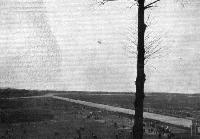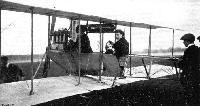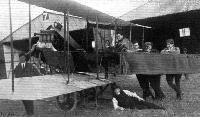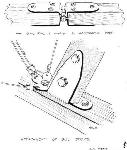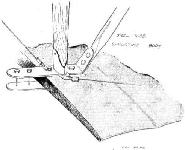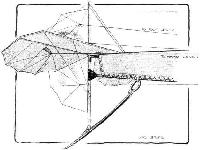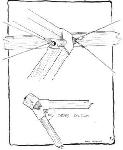
Описание
Страна: Великобритания
Год: 1911
Варианты
- Avro - Type D - 1911 - Великобритания
- Avro - Duigan biplane / Type E prototype - 1912 - Великобритания
- Avro - Type E / 500 - 1912 - Великобритания
- Lakes - Sea Bird - 1913 - Великобритания
- A.Jackson Avro Aircraft since 1908 (Putnam)
- H.King Aeromarine Origins (Putnam)
- M.Goodall, A.Tagg British Aircraft before the Great War (Schiffer)
- P.Lewis British Aircraft 1809-1914 (Putnam)
- Jane's All The World Aircraft 1913
- Журнал Flight
-
P.Lewis - British Aircraft 1809-1914 /Putnam/
Avro D at Brooklands with F. P. Raynham in the cockpit and S. V. Sippe alongside.
-
P.Lewis - British Aircraft 1809-1914 /Putnam/
W. D. Beatty, with Conway Jenkins as passenger, in the Avro D during March, 1911.
-
A.Jackson - Avro Aircraft since 1908 /Putnam/
The original Avro Type D biplane with transverse radiator.
-
M.Goodall, A.Tagg - British Aircraft before the Great War /Schiffer/
The first Avro Type D as originally built.
-
Журнал - Flight за 1911 г.
STARTING FOR THE BRIGHTON RACE. - Mr. H. Pixton getting away for Brighton from Brooklands on the Roe biplane.
-
Jane's All The World Aircraft 1913 /Jane's/
Type D (1911). Photo, Alan H. Burgoyne, Esq., M.P.
-
Журнал - Flight за 1911 г.
FLYING AT BROOKLANDS ON EASTER MONDAY. - In spite of the high wind whteh prevailed at Brooklands, Mr. Pixton, on the Roe biplane, put up a good flight for the Endurance Prize, securing it with 1h. 27m. 32s. In our photograph Mr. Pixton is seen during this flight, the machine on terra firma being one of the famous Bristol biplanes.
Другие самолёты на фотографии: Bristol Boxkite - Великобритания - 1910
-
Журнал - Flight за 1911 г.
CARS AND AEROPLANES AT BROOKLANDS. - Pixton on the Roe biplane during the duration flight at Brooklands on Easter Monday. Below will be noted a race finishing up the straight, with the crowds in the enclosures, and the long wide string of motor cars stretching away beyond the paddock.
-
Журнал - Flight за 1911 г.
Mr. Pixton and the Avro biplane at rest for the night in Mr. England's grounds at Oakwood, Hayward's Heath, May 7th and 8th, en route for Brooklands upon his return flight from Brighton after the recent Brooklans-Brighton Race. On the left the Avro anchored for the night, and on the right ready for the start next morning.
-
M.Goodall, A.Tagg - British Aircraft before the Great War /Schiffer/
Avro Type D biplane with 60hp ENV type F in 1911.
-
P.Lewis - British Racing and Record-breaking Aircraft /Putnam/
The modified second Avro D prepared for R. C. Kemp to pilot in the 1911 Circuit of Britain.
-
A.Jackson - Avro Aircraft since 1908 /Putnam/
The special Type D with E.N.V. engine at Brooklands on the eve of the Circuit of Britain Race, July 1911.
-
P.Lewis - British Aircraft 1809-1914 /Putnam/
Modified Avro D at Brooklands flown by Ronald Kemp in 1911 Circuit of Britain.
-
M.Goodall, A.Tagg - British Aircraft before the Great War /Schiffer/
Avro Type D. Third aircraft with sloping radiator at Shoreham. Pilot A.E. Geere.
-
M.Goodall, A.Tagg - British Aircraft before the Great War /Schiffer/
F. P. Raynham seated in the fourth Type D at Brooklands in October 1911.
-
A.Jackson - Avro Aircraft since 1908 /Putnam/
The fifth Type D was the improved sesquiplane version.
-
M.Goodall, A.Tagg - British Aircraft before the Great War /Schiffer/
Avro Type D. Seventh aircraft with 50hp Isaacson radial at Shoreham.
-
P.Lewis - British Aircraft 1809-1914 /Putnam/
The first Avro D Hydro-biplane equipped with original floats at Barrow for seaplane trials.
-
H.King - Aeromarine Origins /Putnam/
Seen at Barrow-in-Furness, where it first left the water on November 18, 1911, Commander Oliver Schwann's Avro was tried with several different sets of floats. Hydrofoils and air lubrication were both employed.
-
P.Lewis - British Aircraft 1809-1914 /Putnam/
Avro D Hydro-biplane at Cavendish Dock with replacement floats by Vickers.
-
D.James - Schneider Trophy Aircraft 1913-1931 /Putnam/
Commander Oliver Schwann taxi-ing his much modified Avro Type D floatplane at Barrow-in-Furness during August 1911. Numerous float designs were tried before the aircraft would take off.
-
Журнал - Flight за 1912 г.
HYDRO-AEROPLANE EXPERIMENTS AT BARROW. - On the left Commander Schwann's machine, an Avro hydrobiplane, leaving its dock, with Sidney V. Sippe at the lever. On the right the machine is seen skimming the water just prior to taking the air, with its tail well up and the elevators just moved in the position for ascent.
-
Журнал - Flight за 1911 г.
A NAVAL AERO-HYDROPLANE BEING TESTED AT CAVENDISH DOCK, BARROW-IN-FURNESS. - Commander Schwann, of H.M.S. "Hermione," carrying out early morning trials on the Roe biplane, which has been fitted with float attachments of his own invention. The uninitiated should note that the smoking chimney stack has no connection with the biplane.
-
Журнал - Flight за 1912 г.
Sippe well up on the Avro hydro-biplane over Cavendish Dock, Barrow.
-
Журнал - Flight за 1911 г.
Mr. F . Conway Jenkins, one of the latest aviators to qualify for the Royal Aero Club pilot's certificate, on the 30-h.p. Green-engined Avro biplane, upon which he passed the tests on the 30th ult. in a 12-15 m.p.h. wind. This was only Mr. Jenkins' fourth time on the Avro machine, and previous to the official tests he was in the air at Brooklands for forty minutes at about 1,000 ft. height, rising to about 1,800 and finishing with a neat vol plane.
-
Журнал - Flight за 1912 г.
Sydney V. Sippe, who has just secured his certificate on an Avro biplane.
-
Журнал - Flight за 1911 г.
Mr. Pixton, just about to carry a lady passenger for a short trip, on the new Roe biplane, with which he so successfully flew at Brooklands on Easter Monday.
-
Журнал - Flight за 1913 г.
AT THE AVRO FLYING SCHOOL, SHOREHAM. - From left to right, Messrs. Geere (Instructor,) Elliot, Mellersh, England, Rolshoven, and (under fuselage) Shaw.
-
A.Jackson - Avro Aircraft since 1908 /Putnam/
The sixth Type D after its forced landing at Abingdon on January 13, 1912.
-
Журнал - Flight за 1915 г.
TUITION BY MOONLIGHT. - From the original drawing by C. Fleming Williams. This charming picture depicts Mr. Rowland Ding of the Seaplane School, Windermere, giving lessons by moonlight over Lake Windermere - work unique to this special school.
-
Журнал - Flight за 1911 г.
MONOPLANES AND BIPLANES IN THE DAILY MAIL CIRCUIT ROUND GREAT BRITAIN. - From these every machine can be readily identified either in flight or on the ground.
-
Журнал - Flight за 1911 г.
Constructional details of the Avro biplane.
-
Журнал - Flight за 1911 г.
The method employed on the Avro biplane of assembling the wing sections.
-
Журнал - Flight за 1911 г.
Arrangement of the tail unit of the Avro biplane.
-
Журнал - Flight за 1911 г.
The Avro method of cross-bracing the main body.
-
Журнал - Flight за 1914 г.
Fig. 2. - Sections of tail planes: A, Avro tail, 1910-11. B, Nieuport tail, 1910-11. C, B.E. tail, 1911. D, B.E. tail, 1912.
Другие самолёты на фотографии: Nieuport Nieuport-IV - Франция - 1911RAF B.E.1 - Великобритания - 1911RAF B.E.2/B.E.2a/B.E.2b - Великобритания - 1912
-
M.Goodall, A.Tagg - British Aircraft before the Great War /Schiffer/
From the Aviator's Storehouse, the projects for Avro monoplane and biplane.
-
A.Jackson - Avro Aircraft since 1908 /Putnam/
Cdr Schwann with the Type D seaplane at Barrow-in-Furness, August 1911.
-
Журнал - Flight за 1914 г.
Fig. 4. Avro biplane, 1910-11.
-
Журнал - Flight за 1911 г.
THE AVRO BIPLANE. - Plan and elevation to scale.
-
Jane's All The World Aircraft 1913 /Jane's/
Avro. Type D (1911-12)., x1, U.A.S.
A.Jackson Avro Aircraft since 1908 (Putnam)
Avro Type D
In 1911 A. V. Roe abandoned the triplane configuration and designed a biplane which bore a close resemblance to the Roe IV. It was a two-seater with triangular girder fuselage, twin undercarriage and the same type of cumbersome, triangular monoplane tail. This was replaced almost at once by one of rectangular shape. As on Roe IV, lateral control was by means of wing warping but the passenger seat was placed at the C.G. so that the machine could be flown solo without ballast. Power was supplied by a 35 hp Green, the radiator for which, placed vertically behind the engine at right angles to the direction of flight, distinguished this machine from later aircraft of the same type. It is probable that the engine was that knocked down to A. V. Roe for £67 10s. when the assets of the Scottish Aviation Syndicate were auctioned at Brooklands on December 17, 1910.
In later years aircraft of this type became known as the Avro Type D even though no reference seems to have been made to Types A, B, or C. These, of course, would have been designations posthumously applied to the early triplanes.
The first Avro Type D was erected at Brooklands in March 1911 and first flown on April 1 by C. Howard Pixton (who later took Mrs Roe up in it). He declared it stable, viceless and easy to fly, characteristics confirmed by Gordon Bell and effectively demonstrated on April 11 by Lt Wilfred Parke RN who, without having been in an aeroplane before, flew the length of the aerodrome. Numbered 1, it was flown in the Brooklands-Shoreham race by Pixton on May 6, 1911 - the first event in which the Avro entry was not flown by the designer. Pixton lost time at the start because he was flying round in an attempt to win the £500 Manville endurance prize with passenger. He had completed 26 minutes 30 seconds before noticing competitors taking off at the start of the race. He had no map, no cross country experience, and the Type D had never before been flown outside Brooklands Aerodrome. Nevertheless he made a hasty landing to refuel and set off after the others. He lost his way and took three hours for the trip, landing en route at Plumpton Racecourse, seven miles short of his destination. On the way back he spent two days at a flying demonstration at Oakwood, Haywards Heath, returning to Brooklands on Monday May 9 after a very turbulent trip via Dorking. On May 12 he flew the Type D to Hendon in 48 minutes to give a flying display before the Parliamentary Aerial Defence Committee, during which he carried the famous Cdr Sampson RN as passenger and sent A. V. Roe solo in the machine for the first time. Pixton flew home to Brooklands next day and on May 19 made a nonstop flight of 1 hour 30 minutes towards the Manville prize. On June 11 the Type D climbed to a considerable height with the 12 stone Pixton and a 14 stone passenger.
After a flight at Brooklands in June 1911, Cdr Schwann (later AVM Sir Oliver Schwann KCB, CBE) of the Naval Airship Tender Hermione, bought the Type D for £700. It was despatched by rail to Barrow-in-Furness where the original triangular tailplane was replaced, the wheels removed and the skids lashed directly to a series of float undercarriages designed by Schwann and his associates and built by naval personnel. The drag of the floats was partially offset by repositioning the radiator horizontally on top of the centre section and by covering the rear fuselage with fabric.
During first taxying trials on August 2 in the 9 ft deep Cavendish Dock on Schwann’s narrow flat bottomed Mk.I floats, the aircraft assumed such a tail-down attitude on the water that the small tail float caused excessive wash. This and the fin were therefore removed and the rudder moved upward along the hinge line to clear the water. Later the rudder was raised still further till the lower edge was in line with the bottom of the fuselage. Maximum speed was only 18 knots and the machine eventually capsized. Report R & M 69 deals at length with Schwann’s further experiments with seven different types of single and twin float undercarriages. Limited success came on November 18, 1911, after the Green Engine Co Ltd had coaxed an extra 10 hp out of the engine by fitting additional open exhaust ports, and float design had reached the Mk.VII stepped type. On that day the Type D lifted on to the step for the first time and left the water rather unexpectedly, reaching a height of 15-20 ft. Schwann was not at that time a qualified pilot and the aircraft fell back into the water and capsized. After salvage and reconstruction, trials were resumed by S. V. Sippe who made the first of a series of short flights at Barrow on April 9, 1912, during which he reported favourably on the feeling of acceleration from the unstick speed of 25 mph to the flying speed of 40 mph. It became the first seaplane ever to take off from British sea water. On April 12 Sippe made two or three circuits of the dock and reached a height of 160 feet. The seaplane was then handed over to the owner who had just qualified as a pilot at the Bristol School on Salisbury Plain. The feasibility of marine aircraft had been proved but the rate of climb of the Type D seaplane was poor due to an increase in all-up weight to 1,000 lb (an accurate figure obtained by weighing the machine in the airship shed at Barrow). Endurance was but 20 minutes - the time taken for the cooling water to boil away, so a 50 hp Gnome rotary was fitted in an attempt to improve the performance, but there are no recorded flights with this engine.
The sale of the Type D biplane reduced the Avro School to only one aircraft - the Roe IV triplane. Pending delivery of new machines from Manchester, A. V. Roe acquired a secondhand Gnome-engined Farman pusher purchased in Newcastle. The crates housing this relic were too big for railway trucks and travelled south by sea at a cost of £25. This charge contrasted sharply with that for Avro aircraft, which broke down into sections to fit into a single crate, the Manchester-Brooklands rail charge for which was a mere £1 16s. 6d.
The next Avro aircraft was a modified Type D built to compete in the £10,000 Daily Mail Circuit of Britain Race. It was a sesquiplane with upper and lower spans of 33 and 23 feet, powered by a 60 hp E.N.V. eight-cylinder, water-cooled engine. Like all subsequent machines of the type, its fuselage was increased in length from 26 ft to 28 ft, but it was the only one, apart from the prototype, to be fitted with the large triangular tailplane. Construction took place at Manchester during June 1911 under the watchful eye of the pilot, R. C. Kemp, and first taxying trials were made at Brooklands by A. V. Roe on July 18. First flights made by Kemp later in the day showed the machine to be fast, but the engine overheated and the rate of climb was poor with full load of petrol and oil. Without A. V. Roe’s approval, extensions were hurriedly fitted to the lower wing, making it equal in span to the upper and increasing the wing area by 50 sq ft. After an initial test circuit at 100 ft on July 22, morning of the race, Kemp climbed to 800 ft but during a fairly steep descent at half throttle the extension to the port lower mainplane failed at 150 ft. Although he jerked on full right rudder and full left warp, the machine spun into the ground wingtip first and broke up. Miraculously Kemp stepped unhurt from the wreckage.
The third Type D, the assembly of which was completed at Brooklands on September 9, 1911, was almost identical with the first but distinguishable from it because drag had been reduced by fitting the radiator in a sloping position behind the engine. Minor differences included straighter front skids, a covered fuselage and no fin. First straight hops were made by F. P. Raynham on September 11 and after adjustments a flight to 600 ft was made on September 17. Although intended as a school machine, it was entered for the Michelin Speed Prize but during his flight to Hendon to compete on September 21, Raynham ran into thick fog. In attempting to ‘press on’ with primitive instruments, he made what may have been the first recorded spin and recovery, afterwards landing at New Barnet to ask his way. Unsatisfactory experiments with a new airscrew, and sagging wing fabric compelled him to give up the attempt. He therefore returned to base, arriving over Brooklands at 1,000 ft on the evening of September 24 and by the end of the month the Type D was in full time use by the Avro School.
Delivered at Brooklands on September 30, 1911, the fourth Type D was a single-seater but otherwise identical with the equal-span school version, except for the radiator which was fitted vertically behind the engine in line with the direction of flight. The engine was a specially tuned Green giving 45 hp and identified by holes at the base of the cylinder walls which improved scavenging. After some trouble with slack fabric, satisfactory first flights on October 12 again raised Raynham’s Michelin hopes and although he reached 1,000 ft with 5 hours’ fuel (13 gallons) during a practice flight two days later, bad weather on October 15, last day of the competition, ruined his chances. With an eye on the Michelin long distance prize, he coaxed the machine off on October 18 with 8 hours’ fuel (24 gallons) but the attempt came to an abrupt end when the machine forced landed in the sewage farm with an iced-up carburettor on October 27, only three days before the closing date.
The fifth Type D was an improved sesquiplane version generally similar to, and having the same dimensions as, the ill-fated Circuit of Britain machine. The engine was a 35 hp Green.
The sixth machine was a single-seater powered by a new 35 hp five-cylinder Viale air-cooled radial which had been delivered to A. V. Roe on September 30, 1911. The installation was done by Maurice Ducrocq (British concessionaire for Viale engines) and his apprentice Jack Alcock. Work was completed on October 6 but it was not until November 20 that first flights were made by F. P. Raynham. The Viale-powered Type D proved very manoeuvrable and flew strongly in the hands of a number of school pilots. On December 6 Raynham used it for joyriding by removing the fuselage petrol tank to make room for a passenger to kneel facing him. On December 27 Wilfred Parke climbed the machine to 2,500 ft over Addlestone as a prelude to his ‘Superior Brevet’ tests and S. V. Sippe gained his Aviator’s Certificate on it on January 8, 1912. During an attempt to fly to Oxford as part of his tests on January 13, Parke followed the Thames until poor visibility forced him down at Abingdon where he broke two bracing wires and damaged the undercarriage and mainplanes. On the following morning the machine was dismantled in 65 minutes and temporarily stored in a local garage. The ‘broken parts’ of the machine were subsequently sent to the Avro works at Manchester, arriving there on February 16, 1912. The necessary repairs were reportedly almost complete by the end of the same month but there is no record of the aircraft ever having flown again and its Viale engine was installed in the Avro Type F cabin monoplane in the following April.
It is believed that only seven Type D biplanes were produced at the Manchester works. Advertisements making a special offer of 12 Type Ds at a reduced rate of £400 each during October and November 1911 can only be regarded as a publicity stunt. There is no evidence that any orders were placed.
In October 1912 the Avro School moved from Brooklands to the new aerodrome at Shoreham-by-Sea, Sussex, and became the Avro Flying School (Brighton) Ltd with A. E. Geere as CFI. Last noteworthy flights before the transfer were made in mid-August by Wilfred Parke in the old sloping radiator Type D to Staines, Ripley, Hounslow Heath and Walton. The machine was used for instruction at Shoreham during 1913 and became well known along the South Coast as did the school’s 45 hp Green engined Type D, Type D with 50 hp Isaacson seven-cylinder radial, and the Avro Type E prototype described later.
The Isaacson-engined machine was the seventh and apparently final Type D manufactured. Recorded in the Avro works’ log as being under construction on October 31, 1912, the airframe was complete by November 29, 1911, though the engine was not delivered to the factory until December 4, 1912. Its first flight date is not recorded.
SPECIFICATION AND DATA
Manufacturers: A. V. Roe and Company, Brownsfield Mills, Great Ancoats Street, Manchester; Brooklands Aerodrome, Surrey; and Shoreham Aerodrome, Sussex
Power Plants:
One 35 h.p. Green
One 45 h.p. Green
One 35 h.p. Viale
One 50 h.p. Isaacson
One 60 h.p. E.N.V. Type F
Dimensions, Weights and Performances:
Standard Seaplane Sesquiplane
Span, upper 31 ft. 0 in. 31 ft. 0 in. 33 ft. 0 in.
Span, lower 31 ft. 0 in. 31 ft. 0 in. 23 ft. 0 in.
Length 28 ft. 0 in.(*) 26 ft. 0 in. 28 ft. 0 in.
Height 9 ft. 2 in. - 9 ft. 2 in.
Wing area 310 sq. ft. 310 sq. ft. 279 sq. ft.
All-up weight 500 lb. 1,000 lb. 550 lb.
Speed 45-50 m.p.h. 40 m.p.h. -
Range 100 miles(**) - -
(o)Prototype 26 ft. 0 in. (**)With Viale engine.
Production:
No. 1 Prototype, 35 h.p. Green, transverse radiator, first flown 1.4.11, converted to seaplane, last mentioned 4.12;
No. 2 Circuit of Britain machine, E.N.V. engine, first flown 18.7.11, crashed at Brooklands 22.7.11;
No. 3 School machine, 35 h.p. Green, slanting radiator, first flown 11.9.11, withdrawn from use at Shoreham 5.14;
No. 4 Single seater, 45 h.p. Green, fore-and-aft radiator, first flown 12.10.11, withdrawn from use at Shoreham 5.14;
No. 5 Improved sesquiplane, believed that advertised for sale at Shed 4, Brooklands, 5.12 and that reported scrapped near the petrol store 12.12;
No. 6 School machine, Viale engine, first flown 20.11.11, almost certainly re-engined with 50 h.p. Isaacson, withdrawn from use at Shoreham 5.14
No. 7 School machine, Isaacson engine, withdrawn from use at Shoreham 5.14.
Описание:








